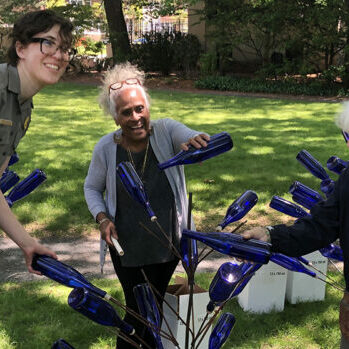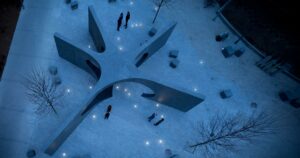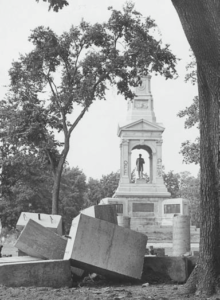
Bottle trees are sprouting up in new locations, continuing to honor the enslaved in Cambridge
Above image: Part of “Forgotten Souls of Tory Row: Remembering the Enslaved People of Brattle Street” is reinstalled at Longfellow House-Washington’s Headquarters. (Photo: History Cambridge)
By Beth Folsom
If you travel regularly along Brattle Street west of Harvard Square, you may have asked yourself in recent weeks, “Where are the blue bottle trees?” Last June, History Cambridge partnered with artists from Black Coral Inc. to create a temporary art installation on the lawn of our headquarters, the Hooper-Lee-Nichols House, at 159 Brattle St. The installation was taken down in April as scheduled, but several of its distinctive blue bottle trees have sprung up along the street, including at First Church in Cambridge and at the Longfellow House-Washington’s Headquarters.
In 2021, History Cambridge launched the Tory Row Anti Racism Coalition, a coalition of individuals and organizations along Brattle Street whose goal is to better understand the role that the profits of enslavement played in building and maintaining the estates in the area, as well as to commemorate the enslaved persons who lived and worked on this land. As part of this important work, we recognized our own legacy of complicity in this economy; although we have not been able to ascertain whether enslaved individuals lived at our headquarters, the Hooper-Lee-Nichols House, we do know that at least three of its former owners enslaved people on other properties they owned.
Last year, History Cambridge was awarded an Arts for Social Justice grant from Cambridge Arts for Black Coral’s “Forgotten Souls of Tory Row: Remembering the Enslaved People of Brattle Street,” honoring the enslaved adults and children who lived and worked on this land as well as those whose labor on Caribbean plantations helped finance the grand homes of white Tory Row elites. Originating among the Congolese in West Africa and dating back to at least the ninth century, the bottle tree tradition was brought to the United States by enslaved people, most notably those who lived in Georgia and South Carolina. This tradition was passed down through generations of enslaved and, later, free Black communities, marking the survival of a cultural practice despite the bonds of slavery. The distinctive blue bottles were placed on tree limbs to capture the energy, spirit and memories of ancestors. Although we do not know all of the names or life experiences of the enslaved people, we aimed to honor their humanity through this installation and restore their physical presence to the land where they once lived and worked.
Since the installation’s deconstructed, History Cambridge has included one of the bottle trees in our newly revitalized front garden beds, and an additional three trees are on view at the Longfellow House-Washington’s Headquarters National Historic Park at 105 Brattle St. A bottle tree is also on display through June 19 in front of First Church in Cambridge at 11 Garden St., Harvard Square.
Black Coral artist Gail Bos says that the bottle trees “help us learn about and acknowledge our true history. We share the history, we share the responsibility [for commemorating those who were enslaved].” Bos’ colleague Pam Goncalves argues that the installation gave the enslaved workers of Brattle Street “a new life, sunlight, fresh air and a place to be free. No one should be forgotten, no matter who you are or where you’re from. No ancestor should ever be forgotten.” The ongoing presence of the blue bottle trees in Cambridge ensures that the lives, experiences and memories of those enslaved here will continue to be remembered by those who travel its streets today.
Beth Folsom is programs manager for History Cambridge.
This article was originally published in our “Did You Know?” column in Cambridge Day.






